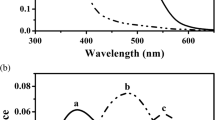Summary
The photoreceptors of the penguin,Spheniscus humboldti, were examined using a microspectrophotometer. The cones could be divided into three classes based on their visual pigment absorbance spectra [λmax 403, 450 and 543 nm (Fig. 1)], and into five classes based on their visual pigment-oil droplet combination (Fig. 4). Oil droplets were of three types (Fig. 2). The rods contained a rhodopsin with λmax at 504 nm. No double cones were observed. The penguin should be capable of good wavelength discrimination in the blue-green region of the spectrum but with poor discrimination at longer wavelengths. It is concluded that the spectral properties of the cone types indicate that the photopic vision ofS. humboldti is adapted to the spectral qualities of its aquatic environment.
Similar content being viewed by others
References
Avery JA, Bowmaker JK (1982) Visual pigments in the foureyed fish,Anableps anableps. Nature 298:62–63
Barlow HB (1982) What causes trichomacy? A theoretical analysis using comb-filtered spectra. Vision Res 22:635–643
Bowmaker JK (1977) The visual pigments, oil droplets and spectral sensitivity of the pigeon. Vision Res 17:1129–1138
Bowmaker JK (1979) Visual pigments and oil droplets in the pigeon retina, as measured by microspectrophotometry, and their relationship to spectral sensitivity. In: Granda AM, Maxwell JH (eds) Neural mechanisms of behaviour in the pigeon. Plenum, New York, pp 287–305
Bowmaker JK, Knowles A (1977) The visual pigments and oil droplets of the chicken retina. Vision Res 17:755–764
Bowmaker JK, Martin GR (1978) Visual pigments and colour vision in a nocturnal bird,Strix aluco (tawny owl). Vision Res 18:1125–1130
Dartnall HJA, Bowmaker JK, Mollon JD (1983) Human visual pigments: microspectrophotometric results from the eyes of seven persons. Proc R Soc Lond B 220:115–130
Delius JD, Perchard RJ, Emmerton J (1976) Polarized light discrimination by pigeons and an electroretinographic correlate. J Comp Physiol Psychol 90:560–571
Emmerton J, Delius JD (1980) Wavelength discrimination in the ‘visible’ and ultraviolet spectrum by pigeons. J Comp Physiol 141:47–52
Engström K (1958) On the cone mosaic in the retina ofParus major. Acta Zool (Stockh) 39:65–69
Fager LY, Fager RS (1981) Chicken blue and chicken violet, short wavelength sensitive pigments. Vision Res 21:581–586
Gallego A, Baron M, Gayoso M (1975) Organization of the outer plexiform layer of the diurnal and nocturnal retina. Vision Res 15:1027–1028
Goldsmith TH (1980) Humming birds see near ultraviolet light. Science 207:786–788
Govardovskii VI, Zueva LV (1977) Visual pigments of chicken and pigeon. Vision Res 17:537–543
Hazlett LD, Meyer DB, Susan SR (1974) Visual cell ultrastructure in the Japanese quail (Coturnix coturnix japonica). Anat Rec 178:371–372
Jane SD, Bowmaker JK (1984) A microspectrophotometric study of the visual pigments and oil droplets found in the retina of the Aylesbury duck,Anas platyrhynchos domesticus (abstract). Vision Res 24 (in press)
Jerlov NG (1976) Marine optics. Elsevier, Amsterdam
Knowles A, Dartnall HJA (1977) The photobiology of vision. (Dawson H (ed) The eye, vol 2B) Academic Press, London New York
Kreithen ML, Eisner T (1978) Ultraviolet light detection by the homing pigeon. Nature 272:347–348
Levine JS, MacNichol EF (1979) Visual pigments in teleost fishes: Effects of habitat, microhabitat, and behaviour on visual system evolution. Sensory Proc 3:95–131
Liebman PA, Entine G (1964) Sensitive low-light-level microspectrophotometer detection of photosensitive pigments of retinal cones. J Opt Soc Am 54:1451–1459
Liebman PA, Granda AM (1975) Super dense carotenoid spectra resolved in single cone oil droplets. Nature 253:370–372
Lipetz LE (1984) Pigment types, densities and concentrations in cone oil droplets ofEmydoidea blandingii. Vision Res 24:605–612
Loew E, Lythgoe JN (1978) The ecology of cone pigments in teleost fishes. Vision Res 18:715–722
Lythgoe JN (1979) The ecology of vison. Clarendon, Oxford
Martin GR (1985) The eye. In: King AS, McLelland J (eds) Form and function in birds, vol 3. Academic Press, New York (in press)
Martin GR, Young SR (1984) The eye of the Humboldt penguin,Spheniscus humboldti: Visual fields and schematic optics. Proc R Soc Lond B 223:197–222
Meyer DB (1977) The avian eye and its adaptations. In: Crescitelli F (ed) The visual systems of vertebrates (Handbook of sensory physiology, vol VII/5). Springer, Berlin Heidelberg New York, pp 549–612
Meyer DB, May HC (1973) The topographical distribution of rods and cones in the adult chicken retina. Exp Eye Res 17:347–355
Mollon JD, Bowmaker JK, Jacobs JH (1984) Variations of colour vision in a New World primate can be explained by polymorphism of retinal photopigments. Proc R Soc Lond B 222:373–399
Morris VB, Shorey CD (1967) An electron microscope study of the types of receptor in the chick retina. J Comp Neurol 129:313–340
Muntz WRA (1972) Inert absorbing and reflecting pigments. In: Dartnall HJA (ed) Photochemistry of vision (Handbook of sensory physiology, vol VII/1). Springer, Berlin Heidelberg New York, pp 530–565
Norren DV (1975) Two short wavelength sensitive systems in pigeon, chicken and daw. Vision Res 15:1164–1166
Rodieck RW (1973) The vertebrate retina: Principles of structure and function. Freeman, San Francisco
Sillman AJ (1969) The visual pigments of several species of birds. Vision Res 9:1063–1077
Sillman AJ, Bolnick DA, Haynes LW, Walter AE, Loew ER (1981) Microspectrophotometry of the photoreceptors of palaeognathous birds — the emu and the tinamou. J Comp Physiol 144:271–276
Sivak JG (1976) The role of the flat cornea in the amphibious behaviour of the blackfoot penguin. Can J Zool 54:1341–1345
Sivak JG, Millodot M (1977) Optical performance of the penguin eye in air and water. J Comp Physiol 119:241–247
Stonehouse B (ed) (1975) The biology of penguins. Macmillan, London
Walls GL (1942) The vertebrate eye and its adaptive radiation. Cranbrook Institute of Science, Michigan
Wright AA (1972) The influence of ultraviolet radiation on the pigeon's color discriminations. J Exp Anal Behav 17:325–337
Young SR, Martin GR (1984) Optics of retinal oil droplets. A model of light collection and polarization detection in the avian retina. Vision Res 24:129–137
Author information
Authors and Affiliations
Rights and permissions
About this article
Cite this article
Bowmaker, J.K., Martin, G.R. Visual pigments and oil droplets in the penguin,Spheniscus humboldti . J. Comp. Physiol. 156, 71–77 (1985). https://doi.org/10.1007/BF00610668
Accepted:
Issue Date:
DOI: https://doi.org/10.1007/BF00610668




